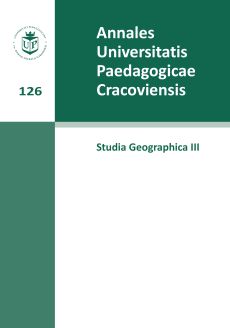Winter tourism of Davraz Mountain
Słowa kluczowe:
Góry Davraz, zimowa turystyka, szkody ekologiczne, klimat, korzyści ekonomiczneAbstrakt
Winter tourism comprises activities such as traveling to snowy and sloping areas in ski centers, accommodation in these areas and other services. For winter tourism, the climate is a major factor. However, a particular altitude and slopes are required. A site could be defined as an available territory for winter tourism if there are places that are suitable for climbing and trekking and have appropriate snow for skiing. In addition to the abovementioned issues, the period during which the snow remains on the ground is also a crucial factor. Mountain Davraz has become one of winter tourism centers because of its altitude of 1650-2250 meters, suitable climate for winter tourism and its location near the center of Isparta town. Moreover, advantages, such as heavy snowfall, low temperatures, geomorphologic features as well as hydrological and vegetational suitability for winter tourism, contribute to its potential. As a winter tourism center Mountain Davraz has available accommodation facilities with qualified staff and climbing equipment like chair lifts, telexes and baby lifts. It should be noted that in recent years, transportation has become possible not only thanks to international airports in Isparta and Antalya, but also due to the construction of highways. All of these features provide benefits to the local economy of Mount Davraz and its hinter land. However, Mount Davraz does not require a big capital for winter tourism, because the real and the biggest capital of Davraz is its own nature. Nevertheless, some issues, like the activities on the plateau, inconveniently steep territory, building tourist establishments, solid and liquid wastes, poaching, biological species smuggling, illegal deforestation, fires and erosion create a dilemma between expecting benefits from tourism and avoiding ecological harm done to the environment.
Bibliografia
Ardos M., 1977, “Eğirdir Güneyinin Jeomorfolojisi ve Barla Dağında Pleistosen Buzullaşması”, İstanbul Üniversitesi Coğrafya Enstitüsü Dergisi, S. 22, İstanbul, s. 99–113
Bahar O., Kozak, M., 2005, Küreselleşme Sürecinde Uluslararası Turizm ve Rekabet Edebilirlik, Turizm Dizisi, Detay Yayıncılık, Ankara
Cengiz Y., 2002, Turizmde Yükselen Deger: Eko turizm, TÜRSAB, Ar-Ge Departmanı, Ankara
Ceylan S., Demirkaya, H., 2007, Davraz Dagı’nın Turizm Potansiyeli Ve Sorunlarını Belirlemeye Yönelik Bir Arastırma, Mehmet Akif Ersoy Üniversitesi Eğitim Fakültesi Derğisi
Ceylan S., 2009, “Davraz Dağı (Isparta)’ nda Kıs Turizmi”, Tourısme De l’hıver Sur La Montagne de Davraz (Isparta), Doğu Coğrafya Dergisi, Sayı.22, Üniversitesi Egitim Fakültesi Dergisi, Erzurum
Çiçek İ., 1992, Isparta Ovası ve Yakın Çevresinin Fiziki Coğrafyası, Ankara Üniversitesi Sosyal Bilimler Enstitüsü, Basılmamış Doktora Tezi, Ankara
Doğanay H., Zaman,S., 2002, “Antalya’da Az Tanınan Bir Kış Turizm Merkezi:Saklıkent”, Doğu Coğrafya Dergisi, Yıl:7, Sayı:8, Erzurum
Doğaner S., 1998, “Dağ Turizmine Coğrafi Bir Yaklaşım: Uludağ’da Turizm”, Coğrafya Araştırmaları Dergisi, Sayı:3, Ankara
Doğaner S., 2001, Türkiye Turizm Coğrafyası, Çantay Kitabevi, İstanbul
Gönençgil B., Güngör, Y., 2002, “Türkiye’de Dağ Turizmi, Potansiyeller, Sorunlar”, Türkiye Dağları I. Ulusal Sempozyumu, 25–27 Haziran 2002, Ilgaz, Kastamonu
Hunziker W., Krapf K., 1942, Grundriß der Allgemeine Fremdenverkehrslehre, Fremdenverkehr - Schriftenreihe des Seminars für Fremdenverkehr an der Handels - Hochschule St. Gallen, Nr. 1. Zürich
Memlük Y. diğ., 2009, “Isparta İli Karlıyayla Kış ve Dağ Turizmi – Doğa Sporları Merkezi Gelişim Projesi”, Isparta Valiliği, Isparta
Özgüç N., 2007, Turizm Coğrafyası, Çantay Kitabevi, İstanbul
Sağlam C., 2007, The Steppe And Rock Vegetation of Davras Mountain and Surroundings (Isparta), Dumlupınar Üniversitesi Fen Bilimleri Enstitüsü Dergisi, Sayı:14, Kütahya
Somuncu M., 2002, “Dünya Dağlar Yılında Dünya’da ve Türkiye’de Dağ Turizmi’’, II.Turizm Şurası Bildirileri, T.C. Turizm Bakanlığı, Ankara, s. 185–192
Soykan F., 1999, “Doğal Çevre ve Kırsal Kültürler Bütünleşen Bir Turizm Türü: Kırsal Turizm”, Anatolia:Turizm Araştırmaları Dergisi, Yıl:10, Mart-Haziran, Ankara, s. 67-75,
Soykan F., 2004, Kırsal Alanların Turizm Potansiyelinin Saptanması ve Şirince Köyü’ne (İzmir) Uygulanması, Yayınevi: Ege Üniversitesi Basımevi, İzmir
Temurçin K., 2004, Isparta İli Ekonomik Coğrafyası, Ankara Üniversitesi Sosyal Bilimler Enstitüsü, Basılmamış Doktora tezi, Ankara
Ülker İ., 1987, “Dünya’da ve Türkiye’de Dağ Turizmi”, Türkiye Kalkınma Bankası Turizm Yıllığı, Ankara
Williams S., 1998, Tourism Geography, Routledge, London
Pobrania
Opublikowane
Numer
Dział
Licencja
Złożenie artykułu do druku oznacza wyrażenie zgody na bezpłatne (tj. bez honorariów autorskich) przeniesienie autorskich praw majątkowych na Wydawcę i zezwolenie na wydanie pracy w postaci drukowanej w dowolnej liczbie egzemplarzy oraz zamieszczenie jej w postaci otwartego dostępu na stronie internetowej czasopisma, w bibliotekach cyfrowych oraz innych cyfrowych platformach wydawniczych, z którymi Wydawca zawarł lub zawrze stosowne porozumienie o udostępnianiu. W przypadku artykułów wieloautorskich przyjmuje się, że autor zgłaszający pracę („correspondingauthor”) ma pełnomocnictwo do reprezentowania pozostałych współautorów w tym zakresie. Autorzy są proszeni o podpisanie stosownego oświadczenia w tej sprawie.

